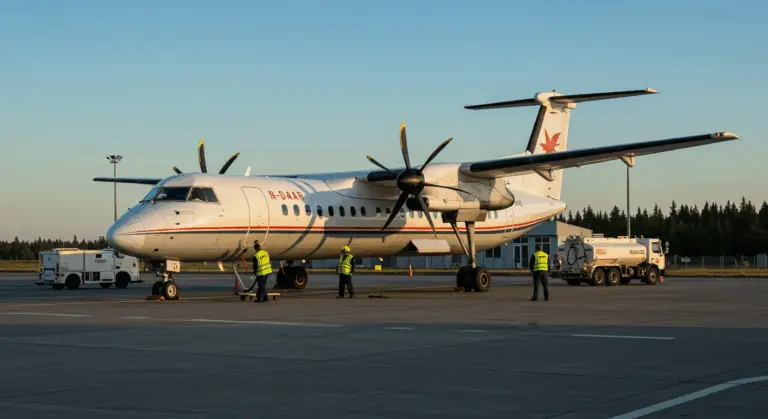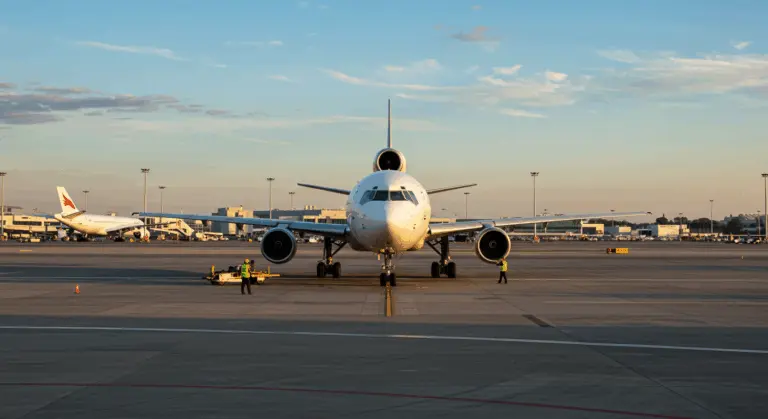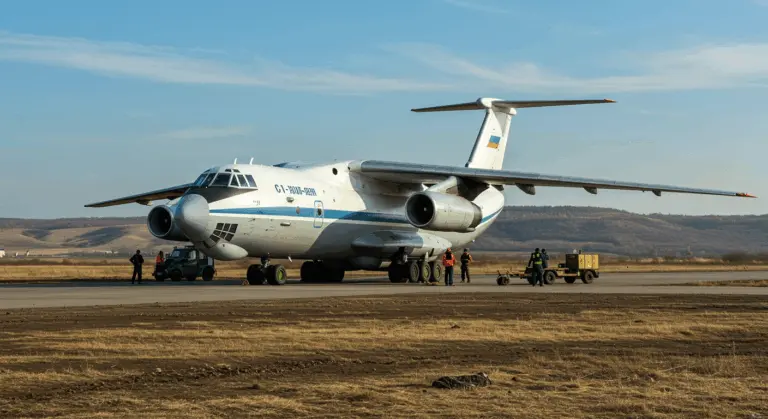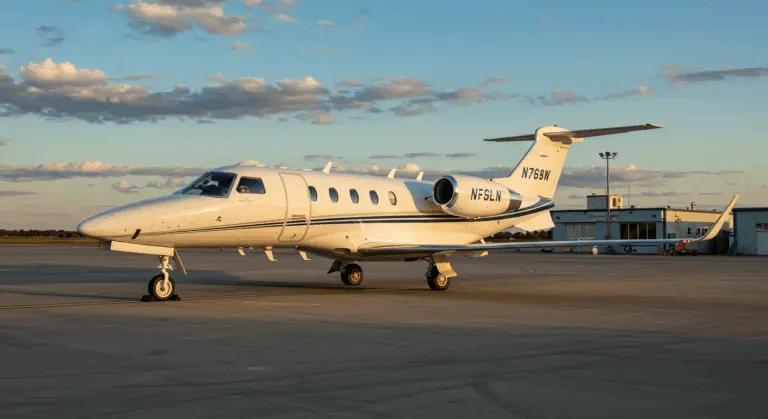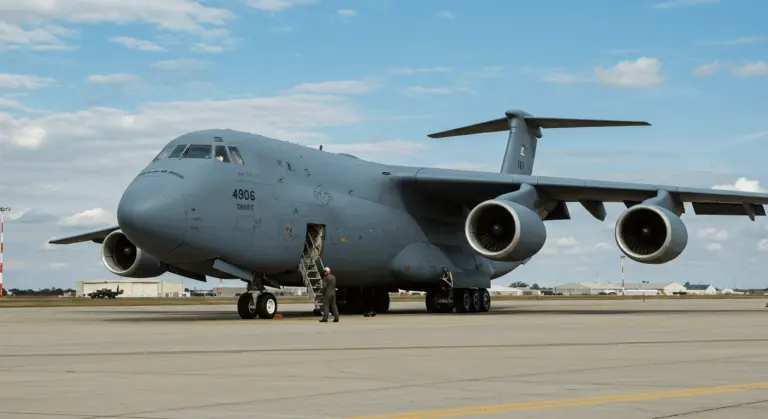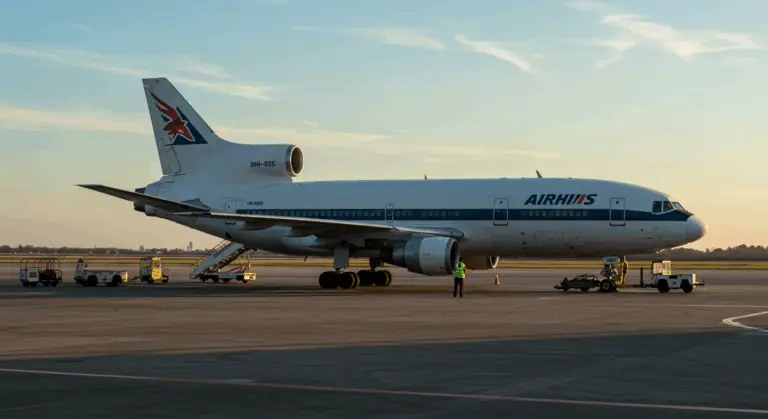Overview of the Airbus A340 – A Long-Range Aircraft
The Airbus A340 stands as a distinguished long-range, wide-body passenger airliner from Airbus. Its distinctive four-engine configuration established a significant presence in commercial aviation from the 1990s through the early 2000s, developed alongside its twin-engine sibling, the A330.
As a quad jet, the A340 delivered unparalleled range capabilities, free from the operational constraints that bound twin-engine aircraft of its era. This capability enabled airlines to establish direct connections between distant metropolises that had previously demanded intermediate stops. The aircraft also emphasized passenger comfort with a spacious cabin and featured advanced avionics and fly-by-wire technology.
History of the Airbus A340 – From Development to Production
The A340’s genesis traces back to the 1970s, when Airbus—then an ambitious European consortium—set out to challenge the dominance of American manufacturers like Boeing and McDonnell Douglas through an innovative family of commercial aircraft.
The program officially launched in June 1987. Four years later, on October 25, 1991, the aircraft took its maiden flight.
Following European certification in December 1992, the A340 entered commercial service with Lufthansa on March 15, 1993. Airbus subsequently introduced the extended-range A340-500 and higher-capacity A340-600 variants during the early 2000s.
Despite remarkable technical achievements, the A340’s commercial trajectory was ultimately undermined by changing market dynamics and advancing technology. The emergence of fuel-efficient, highly reliable twin-engine aircraft—most notably the Boeing 777—steadily eroded the A340’s competitive standing. Facing declining orders, Airbus made the decision to cease production of the A340 family in November 2011 after manufacturing 377 aircraft—a significant but ultimately limited production run in the history of commercial aviation.
Development Timeline – Key Milestones
Production and Testing – Ensuring Quality
The production and testing phases of the Airbus A340 reflected Airbus’s commitment to engineering excellence and operational safety. Each aircraft underwent rigorous testing to validate its structural integrity, systems functionality, and overall performance before delivery to customers. This thorough approach was essential for an aircraft entrusted with carrying hundreds of passengers across oceanic expanses.
The testing regimen included extensive evaluations, such as:
-
Flight tests pushing the aircraft to its operational limits.
-
Wing bending tests to verify structural strength.
-
Fuselage pressure tests to ensure cabin integrity at high altitudes.
Each A340 variant required separate certification from authorities like the European Union Aviation Safety Agency (EASA) and the U.S. Federal Aviation Administration (FAA). This certification process involved demonstrating compliance with stringent safety standards and performance requirements specific to each model’s unique characteristics.
Production centered at Airbus facilities in Toulouse, France, where components manufactured across Europe underwent final integration. The manufacturing process evolved continuously throughout the program’s lifespan, though it predated the advanced composite material applications that would define later Airbus models.
Specifications of the Airbus A340 – Performance Metrics
The Airbus A340 features impressive technical specifications that established its reputation as a premier long-range wide-body airliner. At its heart lies a twin-aisle cabin design that emphasizes passenger comfort while accommodating impressive passenger loads across diverse configurations. The aircraft’s distinctive low cantilever wing with high aspect ratio was engineered to optimize cruise performance at high altitudes, contributing to its excellent long-range capabilities.
Within the cockpit, pilots operate a sophisticated variant of the A320’s glass cockpit, featuring advanced digital displays and fly-by-wire technology. This commonality with other Airbus models provided significant operational benefits for airlines, significantly reducing training requirements for flight crews transitioning between different Airbus aircraft types.
Performance metrics vary significantly across A340 variants, yet all models demonstrate exceptional range capabilities. The A340-300, the most popular variant, offers a typical range of approximately 7,400 nautical miles (13,700 km) with a full passenger load. It achieves a maximum cruise speed of Mach 0.86—roughly 567 mph or 913 km/h—with a service ceiling reaching 41,000 feet (12,500 meters). The aircraft’s maximum takeoff weight ranges from 275 tonnes for the A340-300 to an impressive 380 tonnes for the A340-600.
Component commonality with the twin-engine A330 was a key element of the A340’s design philosophy. This strategic approach allowed Airbus to develop two distinct aircraft types while sharing approximately 60% of parts between them, creating significant manufacturing efficiencies and providing airlines with fleet commonality benefits. This shared design heritage is evident in the similar wing design, fuselage cross-section, and systems architecture between the two aircraft families.
Engine Options – Powering the A340
Airbus carefully chose the A340’s propulsion systems to meet the demanding requirements of long-haul operations, with engine configurations precisely tailored to each variant’s performance objectives. The earlier and smaller variants—the A340-200 and A340-300—are powered by four CFM56-5C4 turbofan engines, each generating approximately 151 kn (34,000 LBF) of thrust. These engines, produced by CFM International (a joint venture between GE Aviation and Saran Aircraft Engines), provided reliable performance while balancing fuel efficiency with the thrust requirements for these initial A340 models.
For the larger, longer-range A340-500 and A340-600 variants, Airbus forged a partnership with Rolls-Royce to deploy a significantly more powerful propulsion solution. These aircraft feature four Rolls-Royce Trent 500 engines, each capable of delivering up to 275 kn (62,000 LBF) of thrust. This substantial increase in power was essential to support the enhanced payload capacity and extended range capabilities of these advanced variants, particularly for the A340-500, which was designed for ultra-long-haul operations.
The quad jet configuration initially represented a strategic advantage, exempting the A340 from Extended-range Twin-engine Operations Performance Standards (STOPS) that restricted twin-engine aircraft on transoceanic routes.
This advantage, however, transformed into an economic burden as fuel prices soared and highly efficient, reliable twinsets like the Boeing 777 emerged, driving up operating costs and accelerating the A340’s market decline.
Variants of the Airbus A340 – Exploring Different Models
The Airbus A340 family comprises four distinct variants, each carefully designed to address specific market demands and operational profiles. These variants differ significantly in dimensions, passenger capacity, range capabilities, and intended mission profiles, providing airlines with flexibility to match aircraft capabilities to their network needs.
| Variant | Length | Typical Seating | Range (approx.) | Notes |
|—|—|—|—|—|
| A340-200 | 59.4 m | 240–260 (3-class) | 8,000 NMI | Designed for exceptional range with moderate capacity. 28 produced. |
| A340-300 | 63.7 m | 275–295 (3-class) | 7,400 NMI | The most successful variant, balancing capacity and range. 218 delivered. |
| A340-500 | 67.9 m | ~300 (2-class) | 9,000 NMI | Ultra-long-haul model that enabled new direct routes. 34 built. |
| A340-600 | 75.36 m | 320–370 (3-class) | 7,500 NMI | High-capacity model designed to replace early Boeing 747s. 97 delivered. |
A340-600 – The Longest Passenger Aircraft
The Airbus A340-600 commands a prestigious position in aviation history as one of the longest passenger aircraft ever manufactured. Stretching a remarkable 75.36 meters from nose to tail, it exceeded even the Boeing 747-400 in length, commanding attention at airports across the globe. This remarkable length allowed Airbus to offer airlines exceptional passenger capacity while maintaining the operational flexibility of a twin-aisle design.
In standard three-class configuration, the A340-600 accommodates up to 370 passengers, though many operators favored more luxurious layouts emphasizing premium seating. Airlines like Lufthansa utilized the aircraft’s generous interior space to install luxurious first-class cabins and comfortable business-class sections, making the A340-600 particularly well-suited for routes with high premium demand, such as Frankfurt to Boston or Hong Kong.
Beyond its passenger capacity, the A340-600 offers impressive cargo capabilities, with substantial belly hold space that complements its passenger-carrying role. This dual-purpose functionality made it an economically attractive option for routes with significant freight demand alongside passenger traffic. The aircraft’s range of approximately 7,500 nautical miles (13,900 kilometers) enables it to connect major global city pairs without intermediate stops.
Developing the A340-600 represented a significant engineering achievement for Airbus. Supporting the elongated fuselage demanded structural reinforcements and a redesigned landing gear system featuring an additional center leg for optimal weight distribution. Powered by four Rolls-Royce Trent 500 engines, each producing up to 56,000 pounds of thrust, the A340-600 offered the performance necessary to operate from high-altitude airports and in hot conditions while carrying full passenger loads. Though eventually overshadowed by more fuel-efficient twin-engine designs, the A340-600 remains an impressive testament to Airbus’s engineering capabilities and vision for long-haul air travel.
Current Operators of the Airbus A340 – Who Still Flies It?
The operational landscape for the Airbus A340 has changed significantly since its production zenith, with the global fleet steadily contracting as airlines migrate toward newer, more fuel-efficient aircraft. As of early 2024, approximately 64 A340s remain in active service with 17 airlines worldwide, according to fleet data from Cerium. This represents a significant reduction from the 377 units originally produced, highlighting the aircraft’s diminishing role in commercial aviation.
Lufthansa remains the most significant A340 operator, maintaining fleets of both A340-300 and A340-600 variants. The German flag carrier strategically deploys these aircraft on select long-haul routes where their unique capabilities match market requirements. Particularly noteworthy is Lufthansa’s strategic use of the A340-600, with its premium-heavy configuration featuring first-class cabins, on routes with strong premium demand. The airline has announced plans to retire its remaining A340-600 fleet by early 2026, though this timeline represents an extension from earlier retirement plans.
Beyond Lufthansa, other operators include a diverse mix of carriers:
-
Mahan Air (Iran): Operates several A340s, partly due to sanctions limiting access to newer aircraft.
-
Edelweiss Air: Uses A340-300s for long-haul leisure routes.
-
Government and VIP operators: Utilize the platform for its range and capacity on specialized missions.
-
Charter and smaller carriers: A few A340s remain in service with these operators.
The A340’s diminishing fleet presence reflects the broader industry trend toward twin-engine efficiency. Major former operators including Air France, Iberia, Virgin Atlantic, South African Airways, and Singapore Airlines have completely phased out their A340 fleets in favor of aircraft like the Boeing 777, Boeing 787, and Airbus A350. This shift stems from the superior operating economics of contemporary twinsets, offering 20-30% better fuel efficiency. While the aircraft continues to fulfill specific operational niches, its footprint in commercial aviation will likely continue to shrink as remaining examples reach the end of their economic service lives.
Safety Record of the Airbus A340 – A Reliable Aircraft
The Airbus A340 has maintained an excellent safety record throughout its operational history, ranking among the safest wide-body aircraft ever manufactured. Most remarkably, the A340 has never experienced a fatal accident despite nearly three decades of intensive commercial service. This zero-fatality record places the A340 in an elite category of commercial aircraft and serves as a testament to its robust design philosophy and operational reliability.
Throughout its operational lifespan, the A340 has suffered merely six hull losses—incidents rendering aircraft damaged beyond economical repair. Most of these incidents were ground-based accidents or occurred in circumstances unrelated to the aircraft’s design or systems integrity. This outstanding safety performance equates to roughly 1.6 hull losses per million flights—substantially superior to industry averages for aircraft of comparable vintage.
Several factors contribute to this stellar safety record:
-
Four-engine redundancy: Allows for controlled flight even after multiple engine failures.
-
Fly-by-wire system: Incorporates envelope protection to prevent unsafe flight maneuvers.
-
Design commonality: Enabled rapid sharing of safety lessons across the Airbus fleet.
The aircraft’s safety record is also upheld by the comprehensive maintenance programs developed for the A340 family, which have been crucial in ensuring the fleet remains airworthy.
Environmental Impact and Future of the Airbus A340
The A340’s environmental footprint creates significant challenges in today’s increasingly eco-conscious aviation landscape. Conceived as a four-engine wide-body during an era when fuel efficiency commanded less attention, the A340 faces considerable disadvantages against modern twin-engine alternatives. The aircraft’s four CFM56 or Rolls-Royce Trent 500 engines consume substantially more fuel per passenger-kilometer than contemporary designs, resulting in higher carbon dioxide (CO₂) emissions—approximately 30-50% more than newer aircraft like the Airbus A350 or Boeing 787 on comparable routes.
This environmental performance deficit has grown increasingly problematic as airlines face increasing pressure to shrink their carbon footprints. Many jurisdictions have implemented or are considering carbon taxation schemes that directly impact operating economics, further disadvantaging aircraft with higher emissions profiles. Additionally, industry commitments to carbon-neutral growth and eventual emissions reductions have accelerated the retirement of less efficient aircraft types, including the A340.
Consequently, the A340’s future prospects look quite limited. Most major airlines have already phased out their A340 fleets as part of broader sustainability strategies, replacing them with more efficient twin-engine aircraft. Lufthansa, the largest remaining operator, has announced plans to retire its A340-600 fleet by early 2026. The secondary market for A340s has deteriorated markedly, with numerous retired airframes being dismantled for parts rather than securing new operators.
Some A340s may find extended service lives in niche applications despite their environmental drawbacks, such as:
-
VIP and government transport.
-
Specialized charter services.
-
Use by carriers in regions with lower environmental regulatory pressures.
Conclusion – The Legacy of the Airbus A340
The Airbus A340 has established an important legacy as a technologically sophisticated aircraft that helped establish Airbus as a formidable competitor in the long-haul market.
Its main achievement was expanding global connectivity through pioneering ultra-long-haul routes—a capability enabled by its four-engine architecture that circumvented the STOPS restrictions of its time.
Yet the A340’s narrative also demonstrates how market forces can shift—its four-engine design transformed from advantage to economic liability as fuel costs soared and efficient twinsets emerged.
Despite its constrained production run, the A340 earns recognition for its exemplary safety record and passenger comfort. Its technological innovations significantly influenced subsequent aircraft like the A330 and A350, establishing its role as a pivotal transitional airliner bridging the era from four-engine designs to modern twin-engine supremacy.

